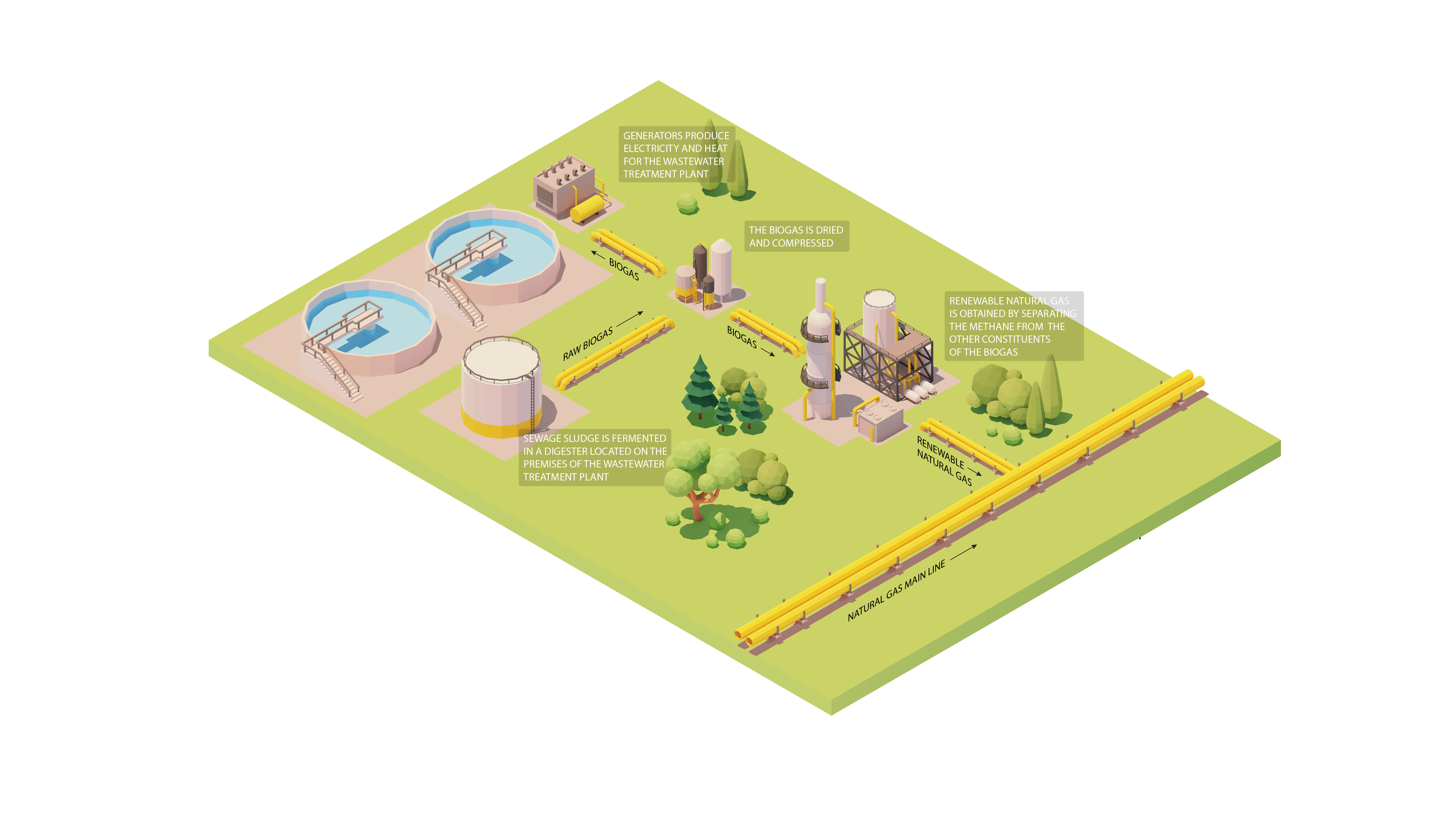Benefits of alternative fuels and fuel-flexibility
By Aytek Yuksel, Content Marketing Leader - Power Systems

Internal combustion engines using traditional and alternative fuels are an integral part of life in all parts of the world. They are almost universally used in motor vehicles of all kinds, in power generation, and more. Traditionally, internal combustion engines run on liquid fuels. These fuels are distilled from petroleum. Think gasoline, diesel, kerosene or heavy fuel oil.
What are alternative fuels?
Liquid fossil fuels are convenient and affordable, but they are not the only fuels that engines can burn. In fact, alternative fuels have been available for as long as internal combustion engines have existed. For example, vehicles running on a fuel known as wood gas were widely used during World War II. This allowed to save fuel needed for the war effort. Wood gas was generated by the incomplete combustion of wood chips. The process would take place in a sort of large kettle. The kettle could be placed on a trailer behind a vehicle, and from there piped to the vehicle's engine.
Today, few vehicles run on wood gas, but many other alternative fuels are available, and several more are being developed. Some, such as compressed natural gas (CNG) and liquid petroleum gas (LPG—a mix of propane and butane), are derived from fossil fuels. Others, such as renewable diesel, biodiesel, ethanol and biogas are obtained from energy crops or from organic waste. You can check out what are the low carbon fuels to learn more.
Advances in chemical engineering and other disciplines have also made it possible to synthesize methane, hydrogen, diesel and more from non-fossil feedstock such as carbon dioxide (CO2) and water using renewable electricity. These synthetic fuels are sometimes known as e-fuels. You can check out what are power-to-x and e-fuels to learn more.
Renewable diesel can be used as drop-in replacements. For most engines, no modification is required. Biodiesels must be blended with fossil diesel to be used in standard compression ignition (CI) engines. Ethanol-basically, alcohol-can also be used in traditional SI (spark ignition) vehicles when it is blended with gasoline. Ethanol blending is extremely common. More than 98% of all gasoline sold in the United States contain a significant proportion of ethanol.
For example, The Cummins Inc. Ethos spark ignited engine can run E85 (85% ethanol) without any modification. Meanwhile, engines capable of running flex fuel can use a blend of gasoline and ethanol from 51% to 83% (E85). Vehicles with this capability, known as fuel-flex vehicles, are not rare-according to the U.S. Department of Energy, there are more than 21 million fuel-flex vehicles driving on US roads.
What is fuel flexibility?
Fuel flexibility is also an option for equipment owners who wish to use CNG or LPG as an alternative to gasoline. Either can be achieved with the addition of a separate fuel system and the addition of a new set of fuel injectors in the engine. Owners of dual-fuel vehicles can thus run on CNG, and, if no CNG fueling station is nearby when the gaseous fuel runs out, continue driving on gasoline.
Alternative fuels are not just for road vehicles. Agricultural machinery, mining equipment, ships, locomotives, and other vehicles can all potentially benefit from using alternative fuels. Alternative fuels are also an option for stationary internal combustion engines. Stationary engines are commonly used in industrial applications such as oil and gas extraction or power generation. Power plant owners can more easily meet their operational and financial objectives when they have the option to use either traditional diesel, biodiesel or natural gas in their power plant. Power plants based on reciprocating engine power generators, for example, can start their engines on natural gas. Once the engines are running, they can be switched to biodiesel, allowing net CO2-free operation.
Businesses operating fleets of vehicles are constantly making tradeoffs between multiple objectives such as reducing capital costs, reducing maintenance costs, reducing fuel costs, and reducing emissions, while taking into consideration range and refueling constraints, among others. Adopting the use of an alternative fuel can help further one or more of those objectives.
Environmental benefits of alternative fuels
Using an alternative fuel can be a good way to reduce carbon emissions. Burning fossil fuels releases carbon into the atmosphere that was previously stored underground.
Biofuels, in contrast, release the carbon which was taken from the atmosphere by the crops that they are made from. This is why biofuels are thought of as net-CO2 free fuels. Similarly, renewable natural gas fuel produced from landfill, or sewer gas can be considered as a fuel with negative carbon intensity.
For businesses who wish to reduce their carbon footprint, alternative fuels present a variety of options. Switching to CNG or LPG can result in significant CO2 reductions, despite their fossil nature. Using a fuel with a greater ethanol or biodiesel content can also be effective. For businesses seeking further reductions in CO2 emissions, full conversions to biodiesel, hydrotreated vegetable oil (HVO), ethanol, renewable natural gas, or even hydrogen, or an e-fuel may also be an option.
Besides CO2, internal combustion engines emit other gases in their exhaust. Most businesses should be concerned by the non-carbon emissions of their vehicle fleets. Clean-burning alternative fuels can help in that regard. In some cases, for example, converting a diesel truck to run on CNG can be more cost effective in the long run than investing in diesel exhaust emissions control equipment.
In certain industries, additionally, non-carbon emissions pose a specific set of problems. These problems can lead to transformative solutions designed around an alternative fuel. Mines, for example, require a powerful ventilation system in order to maintain a safe and breathable environment. With heavy machinery operating underground, this is no easy task. Operating that ventilation system can be very costly and consume a lot of energy. These considerations have led several mining companies to explore options to fuel this machinery with hydrogen. Using hydrogen as a fuel would result in no emissions at all, and thus far smaller ventilation needs.
Economical benefits of alternative fuels
Traditional fossil fuels such as gasoline and diesel are generally convenient and affordable, but there are situations where alternative fuels are cheaper. Natural gas, specifically, has been consistently cheaper than gasoline and diesel when measured on a gasoline gallon equivalent basis. Operators of city buses, dumpster trucks and other commercial vehicles have saved millions of dollars by converting their fleets to run on CNG.

In addition to being low, the price of natural gas is also stable over time. Natural gas prices tend to avoid the cyclical price fluctuations that petroleum-based fuels such as gasoline experience. As a result, owners of compressed natural gas vehicles enjoy operating costs that are both lower and more predictable.
Maintenance and other advantages of alternative fuels
Alternative fuels present a variety of other advantages. Here are some additional benefits:
- Shelf life: Unlike gasoline and diesel, natural gas and propane have an unlimited shelf life, as do hydrogen and ammonia-based e-fuels. This is also true of several newer biodiesel and synthetic diesel formulations, which can last up to 10 years.
- Environmental compatibility: Biodiesel and renewable diesel are also biodegradable, non-toxic and produce less fumes. Likewise, LPG and natural gas are not likely to result in any soil or water contamination if spilled, since they would simply vaporize.
- Reduced maintenance needs: Natural gas and propane tend to burn cleaner than liquid fuels. A lesser amount of soot thus makes its way into the engine’s oil. Some operators take advantage of this by extending oil change intervals. When a large fleet of vehicles are involved, this can easily result in a savings of tens of thousands of dollars or more.
- Performance: Biodiesel and ethanol blends also have higher cetane and octane ratings than unblended diesel or gasoline, providing improved performance and acceleration. This is one of the reasons why; in the United States, NASCAR advertises its use of a blend of ethanol and gasoline containing 15% of ethanol—significantly more than the average fuel available at the pump.
Alternative fuels are far more common than many people realize. Several types of alternative fuels with a proven track record are available and, when deployed judiciously, can help businesses meet their environmental and cost reduction objectives.
Benefits of alternative fuels specific to your business
Your business has distinct characteristics and needs. As a result, you might find some of these alternative fuels more valuable than others. There are also other factors such as fuel availability, use case, and local regulations that you need to consider.
These additional factors often are more localized. You can benefit from working with a partner knowledgeable in these local aspects and understand your business more intimately. We recommend you reach out to a local partner to find the best fit solution for your business and needs.
Alternative fuels’ compatibility with different engines
Whether you are in marine, mining, rail, power generation or another sector, you may be wondering if your equipment is compatible with different alternative fuels. Please work with your Cummins partner to find the most up to date information about your engines and alternative fuels available for your needs.
Author Profiles

Aytek Yuksel, Content Marketing Leader - Power Systems
Aytek is a marketing leader at Cummins, focusing on technology and thought leadership. Since joining in 2008, he has held various marketing roles and now shares insights on markets, technologies, and energy transition. Aytek lives in Minneapolis with his wife and two kids.
Temas relacionados
Related Tags